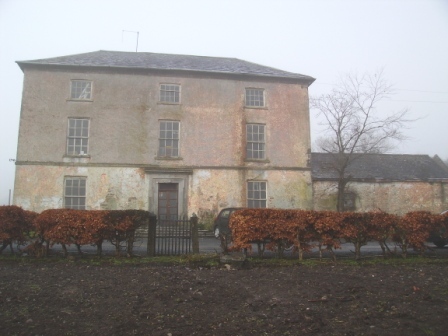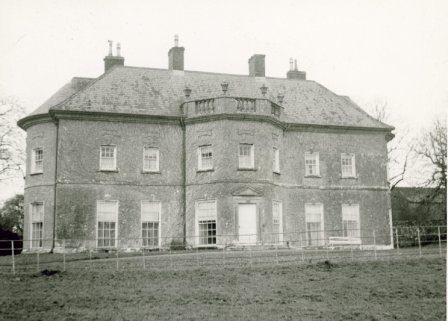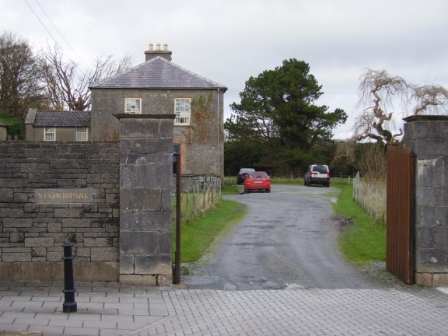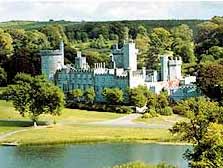Carnelly
Houses within 5km of this house
Displaying 20 houses.
Houses within 5km of Carnelly
Displaying 20 houses.
| House name | Description | |
|---|---|---|
| Claremount House | Claremount house and demesne were part of the Barntick estate. Occupied by Jonas Studdert in 1814 and by Wyndham F. Patterson at the time of Griffith's Valuation. His lease expired on 25 Mar 1857. It was then leased to the Lynch family. One descendant was Patrick Lynch, Senator of the Irish Free State and Attorney General of Ireland 1936-1940. | |
| Barntick | A 3 storey house dating back to the 17th century, it was originally a Hickman home. The Hickmans sold the property to the Peacockes in the mid 18th century. In 1786 Wilson refers to it as the seat of Mr. Peacocke. Occupied by Daniel Powel in 1814 the house was later owned by the Roche family of Limerick and leased to the Lyons, who eventually bought the property. Now owned by the Murphy family through marriage with a member of the Lyons family. |

|
| Buncraggy | A home of the Burton family in the 18th century though Wilson refers to it as the seat of Mr. Armstrong in 1786. It was held by James O'Gorman from the Marquess of Conyngham at the time of Griffith's Valuation. The house remained in the possession of the O'Gorman family until the end of the 19th century when it became the property of the Caher family. The house is still occupied and the yard buildings are the centre of a farming enterprise. |

|
| Islandmagrath House | Originally a Burton property bought from the Earl of Thomond, Islandmagrath was leased to Edward Maunsell by the Marquess of Conyngham at the time of Griffith's Valuation. It is described as "steward's house", with a £10 valuation. A house and farm buildings are still extant at the site. | |
| Manus House | Weir writes that John Hartigan of Manusmore was the Clare County Surveyor. He died in 1756. Manusmore was occupied by Thomas Lynch in 1814 and by Terence Healy at the time of Griffith's Valuation. Other occupiers in the latter half of the 19th century were George Walton and Hugh Tarpey. The McInerneys of Ennis bought the farm in the 1890s and have lived there for over a hundred years. | |
| Manus South House | Weir writes that this house was built by the Healy family. It was occupied by James Healy at the time of Griffith's Valuation and was valued at £20. Both Healy houses at Manusmore were leased from Colonel George Wyndham. This house is now the home of the O'Halloran family. | |
| Eden Vale | William Stacpoole moved from Annagh to Eden Vale in 1776 and this house continued to be the main Stacpoole residence until it was sold to the Clare Board of Health in the 1920s. In 1786 Wilson refers to it as the seat of William Stacpoole. At the time of Griffith's Valuation it was occupied by Richard J. Stacpoole and valued at £50. The house was a tuberculosis sanatorium in the 1940s. It is still extant. |

|
| Newhall | The original house was bought from the O'Briens by Charles MacDonnell in 1764 who greatly extended the property building on a new front, probably designed by Francis Bindon. Occupied by Robert and Florence Vere O'Brien in the 1890s though Slater notes it as a seat of Charles R.A. MacDonnell in 1894. A home of the Joyce family of county Galway in the 20th century. It is still extant and in 2013, was offered for sale. |

|
| Cahircalla House | Occupied in the 18th century by the Crofts, England and Maguire families. The residence of David A. England in 1814 and of Charles Mahon in 1837. Griffith's Valuation shows that he held it from John Clancy. By the end of the 1860s Wainwright Crowe was in residence. Cahircalla Hospital now occupies the site, incorporating some of the earlier buildings. |

|
| Ashline Park | Robert Mahon son of Charles of Corbally and his wife Rebecca Crowe lived here in the mid 19th century. Griffith's Valuation shows the house valued at £18 and that it was held from the representatives of Michael Finucane. In the 20th century the house was the residence of the Catholic Bishop of Killaloe for some time. Weir writes that it was demolished circa 1968. | |
| Stamer Park | A home of the Stamer family in the 18th century which was occupied by Daniel Finucane, Secretary to the Clare Grand Jury, by the beginning of the 19th century. Daniel's son Michael was resident in 1837. By 1860 Captain William Stacpoole who was elected Member of Parliament for Ennis was living in the house. The house is still extant. |

|
| Clonroad | A 17th century house in the possession of the Gore family from 1712 until 1852. The house was close to the River Fergus and had a brewery beside it. At the time of Griffith's Valuation the Gores were leasing the house and brewery to William Digges and the house was occupied by Henry Greene. In the 20th century the house which was rebuilt and extended in the mid 19th century belonged to the Knox and Merry families. | |
| Ballygirreen | At the time of Griffith's Valuation Ballygirreen was occupied by Francis O'Donohoe who held the property from Lord Inchiquin. The value of the buildings was £12 in the mid 1850s and in 1906. A house is still extant at the site. | |
| Dromoland | This branch of the O'Briens have lived at Dromoland since the 17th century when they moved from Leamaneh Castle near Corofin to Dromoland. The present building was constructed in the 1830s to the design of James and George Richard Pain replacing an earlier house. In 1962 it was sold to Bernard McDonough, an American of Irish descent, who turned it into a top class hotel. The present Baron Inchiquin lives in Thomond House nearby. |

|
| Latoon House | A 19th century house on the O'Brien estate, occupied by John Lynch in the mid 1850s and valued at £18. | |
| Castlefergus | A Blood Smyth property from the late 18th century, sold by the Blood Smyth to the Bloods of Ballykilty in the early 20th century. This house was occupied by Daniel Powell in 1814 but the Blood Smyths were in residence in the 1830s and 1850s. They appear to have held the property from Ralph Westropp. The mansion house of Castlefergus was in the possession of Rev William Blood Smith in 1906. The Irish Tourist Association Survey File records that the house was demolished by the Irish Land Commission. | |
| Ballykilty | A McMahon residence in the 1730s, In 1786 Wilson notes it as the seat of Mr. McMahon. Weir writes that the lease of Ballykilty was purchased by John Blood in 1785. Occupied by Robert Young in 1814 and by John Blood in 1837 and at the time of Griffith's Valuation. He held the property from William Monsell. The front of the house was replaced following a fire in the 19th century. Functioned as a hotel in the latter part of the 20th century and now the site of a major hotel development. | |
| Harmony House | The residence of Patrick Maxwell Cullinan on the River Fergus in Ennis in the 1870s. Local sources indicate he afterwards moved to Cragleigh House. | |
| Ballyhannon | Weir writes that this is a mid 19th century house and was the home of Thomas Studdert. This house valued at £24 was occupied by his representatives in 1906. It is still extant. |

|
| Cappahard House | In 1786, Wilson refers to Cappaghard as the seat of Mr. Lukey. Two houses are shown in this townland at the time of the 1st Ordnance Survey, Cappahard House and Edenview House. By the 1890s the 25-inch map shows that Edenview has become known as Cappahard House and the original house has gone. This townland was the property of Thomas Persse at the time of Griffith's Valuation and included a herd's house valued at £4. In 1901 it was occupied by the Glynn family. |

